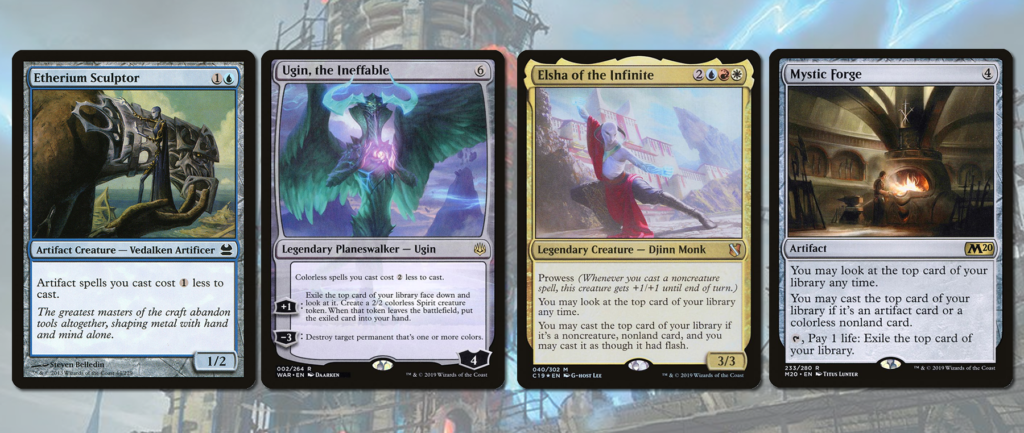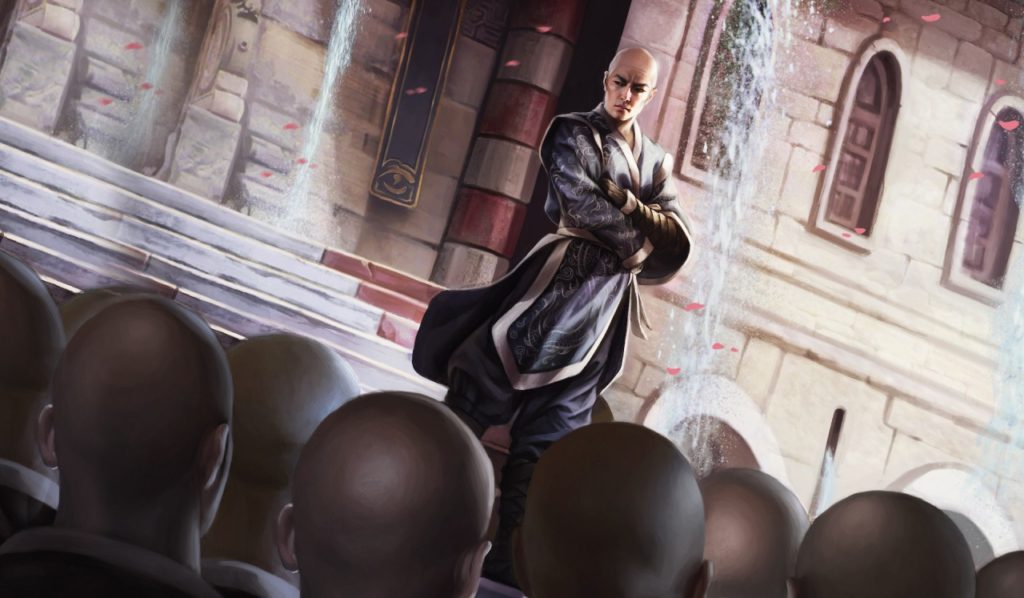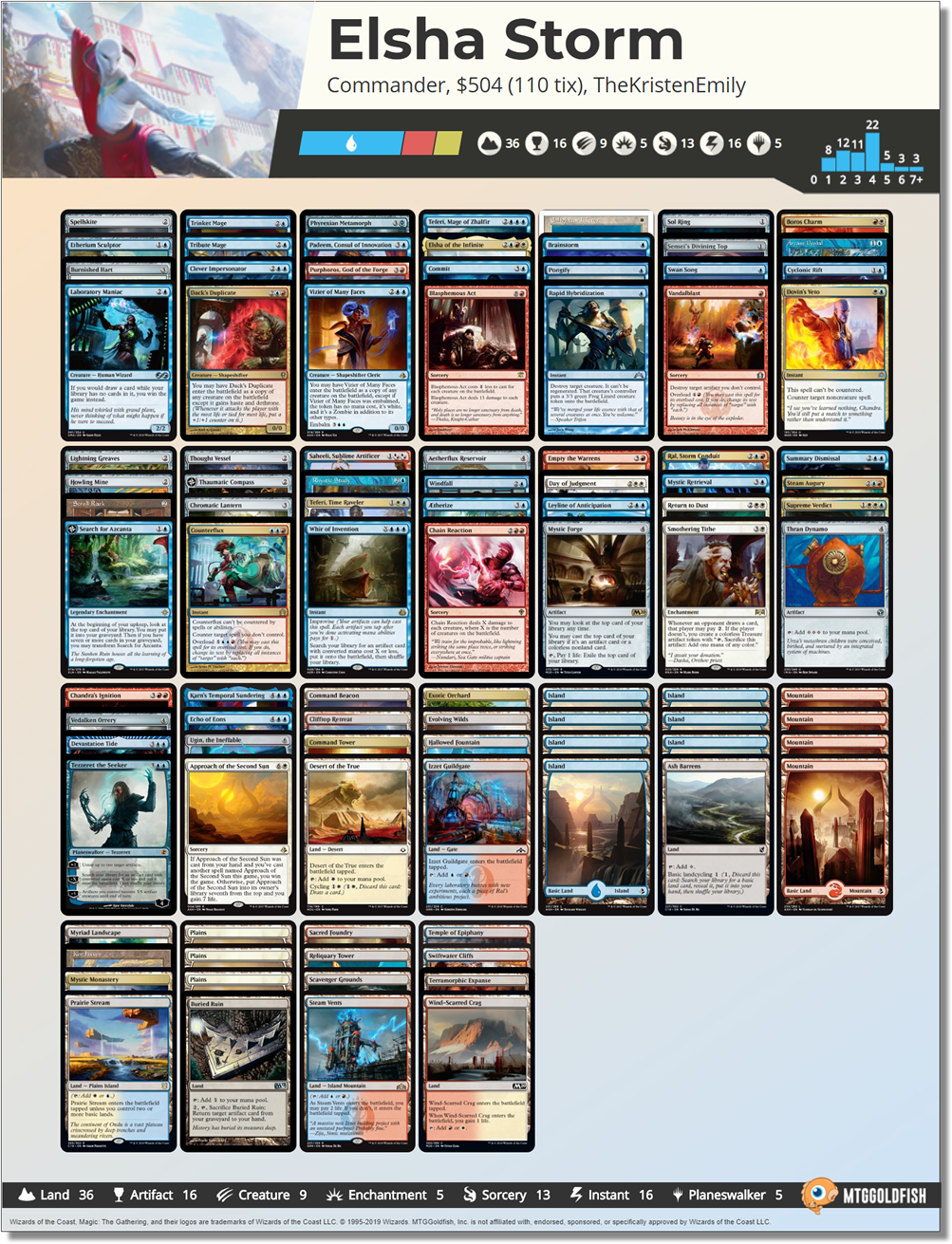This week on Legion’s Landing, Kristen further explores the idea of uniqueness in Commander decks by evaluating the idea of conserving design space when deckbuilding. If you haven’t had a chance yet, you can read her previous article on keeping gameplay fresh here.
Two of my favorite Commanders to come out in 2019 are Kykar, Wind’s Fury and Alela, Artful Provocateur. It’s been a little while since we last received such a variety of great token action in the Command Zone, with this past year or so granting us a wealth of options: the strongest of which include God-Eternal Oketra, Krenko, Tin Street Kingpin, Sai, Master Thopterist, and Brudiclad, Telchor Engineer.
What really interests me, though, is getting to experiment in Jeskai and Esper colors with token-producing Commanders that reach for the heights achieved by Ghave, Guru of Spores and Edgar Markov.
There were two main factors affecting my deckbuilding when it came to looking at these two legends: the printing of (and my subsequent building of) Elsha of the Infinite limited my available paper shell for building Kykar; and the fact that all three of these decks could potentially occupy the same design space: artifact “storm.”
Metal Working
Elsha & Kykar take advantage of noncreature spells. Living in Jeskai, the obvious synergy is with artifacts. While you may associate storm with spell-slinging, artifact-based storm tactics are often easier to pull off and more consistent. There are more ways to cheat artifacts into play, there are more zero cost artifacts (or ways to make them cost zero), and they can also be cast with any color of mana. So, while your “finisher” might be a big mana Blue or Red spell (either mill or burn), the way you get there is very likely to be via artifacts.
With this in mind, my first decision point (before Alela was even revealed) was to make sure that my Elsha build would differ from Kykar significantly enough that I’d still feel inspired to build the bird wizard once I’d had my fill.
Limiting Linearity
The main win condition for my Elsha of the Infinite deck is to resolve both a way to make Sensei’s Divining Top cost zero mana, and a way to cast the top card of my library; I can then proceed to draw my entire deck by recasting the Divining Top for free. This achieves two things—it can either make Elsha very large from Prowess triggers, or it can inflate the Storm count (the amount of spells cast this turn) to a level that would trigger abilities enough times to defeat my opponents.
The main enablers of this strategy are Etherium Sculptor, Ugin the Ineffable, Mystic Forge, and Elsha herself. Vedalken Orrery and Leyline of Anticipation both enable us to complete these actions at instant speed, which leaves us much less vulnerable to interaction.

To give us multiple shots at winning, and also to keep the gameplay fresh, I’ve included a number of different paths to victory. We have a copy of Purphoros, God of the Forge and Ral, Storm Conduit in the deck. Both of these will ping each opponent for damage either when a creature enters the battlefield, or each time we cast or copy an Instant or Sorcery. Empty the Warrens will give us a win with either of these permanents in play. Additionally, we play Saheeli, Sublime Artificer, which gives us an extra token producer for every time we cast the Top.
These aren’t the only ways to win, though. We can also use two of the most popular Storm win conditions, Laboratory Maniac and Aetherflux Reservoir. Both of these are fairly self explanatory, and work by us drawing our library with the Top or Storming off into the Reservoir. That’s not all, though—we also run Chandra’s Ignition, a burn spell that works from the Prowess we stack on Elsha—it can do massive damage to our opponents to destroy them. If all of that doesn’t work, there’s a copy of Approach of the Second Sun.
Playing a combo deck is always like operating a glass cannon, and so having a wealth of routes and styles of victory is an advantage when you have no idea what decks you’ll be facing. If opponents are removal heavy, Laboratory Maniac is less strong, but if our opponents are creature heavy, leaning in to Chandra’s Ignition might be the way forward. I like having options not only to keep things fresh, but to keep our opponents on their toes.
Getting Up and Running
The deck does require a fair bit of mana investment to get (and keep) all of the pieces in place. Whilst it’s certainly capable of winning on turn 5-6 with a perfect draw, the deck usually aims to play the control seat and wait for a perfect moment, which means it generally attempts to go for victory around turn 10-12. That said, it’s definitely consistent, and I’d say easily shoots for at least a 7 on the power scale, and probably higher if your playgroup is ill-equipped to deal with it.
Trinket Mage and Tribute Mage both seek out our pieces; with Enlightened Tutor, Tezzeret the Seeker, and Whir of Invention giving us extra ways to get what we want. Padeem, Consul of Innovation, Boros Charm, and Spellskite help us keep our opponent’s grubby mitts from interfering; and both Teferi, Time Raveler and Teferi, Mage of Zhalfir give us all the breathing room we could ever need.
If we do lose our key pieces, cards like Mystic Retrieval can get them back, plus we also have Echo of Eons and Commit // Memory to shuffle our Divining Top back in if it gets destroyed. Speaking of Wheels, we also run Windfall and Smothering Tithe. I’ve spoken before about the power of this interaction, and here, it gives us a bunch of extra mana to help increase our Storm count.
Most of the rest of the deck is comprised of ways to “not die”—from Fog effects like a flipped Thaumatic Compass and Kor Haven, to board wipes like Supreme Verdict. The strength of the deck being able to play at instant speed most of the time, either through Elsha or Leyline/Orrery, cannot be understated.
The only other point I’d like to touch on is the use of clone creatures. Clones are a great way to scale a deck’s power level with the table, but they also offer us some great utility here. Clever Impersonator and Phyrexian Metamorph can both be copies of our key board pieces which can stop us being blown out by removal, whilst also helping us win quicker by being a second Aetherflux Reservoir when needed. Vizier of Many Faces can be used twice, which is great when we’re wiping the board so often, and Dack’s Duplicate having haste gives it a lot of flexibility.
Potential Upgrades

Monastery Mentor by Magali Villeneuve
The build I have is on paper, so in the spirit of keeping design space fresh, I’ve eschewed staples like Path to Exile and Swords to Plowshares in favor of Rabid Hybridization and Pongify. Of course, the astute amongst you can tell me that I’m lowering my power level by doing so, but that’s a conscious decision on my part; I only have so many paper copies of cards, and the manabase in the deck is definitely more blue, so I will more consistently have access to the one blue mana when I need it. I mean, why not both, right?
It could also probably find space for cards like Teferi’s Protection, Timetwister, and Monastery Mentor (though Saheeli is harder to remove, all said and done). All fine inclusions, but out of my budget for this build. It’s freeing to accept that you don’t have to build to any preconceived notions of “best” deck in Commander (outside of competitive EDH); and when you’re comfortable with that, it’s not a big deal to be missing cards. Helm of Awakening is one such card I’m missing, but not something I feel like I need to purchase to have the deck be functional.
Sai, Master Thopterist would be a good fit for the deck, though—he enables Purphoros. I’ve decided to leave him out of this build though, in favor of saving him for Kykar.
Oh, and 36 is a little low for lands usually; but in this deck, Elsha really doesn’t want to see them on top of the library. We should be able to ramp enough while still hitting land drops with 36.
New Horizons
All in all, my build for Elsha provides lots of fun and fresh gameplay in a color combination I don’t usually play in. With the many win conditions, and lines of play required to get there, the deck doesn’t become stale like it should given that all win conditions center around one card: Sensei’s Divining Top. All roads might lead to Rome, but there’s some great scenery on the way.
There’s something to be said, too, for the idea that having mechanically different decks gives the most replay value. Top-deck manipulation is certainly high on the list for uniqueness, and even if it will inevitably share cards with a Kykar build, the deck will hopefully feel different.
It’s the same reason that I’ve forgone playing Sword of Feast and Famine and a Sunforger package in my Sylvia & Khorvath build. Sure, they’re the optimal cards for Boros, but I’ve run those cards to death, and I like to keep gameplay fresh and exciting and explore other cards I don’t usually play. If you wanted to check out some gameplay of that deck, Commander Replay took it for a spin this week—definitely check out his channel if you haven’t already. PJ is a great guy with some tight and entertaining content.
That’s it for Part 1 of this article. Next time, I’ll be looking to continue the discussion with how I built Alela, Artful Provocateur while conserving design space. There’s arguably greater potential for Alela and Kykar to overlap, and so I’ll be going in depth on my decision process.
Kristen is a lover of both Limited and Commander, and can most often be found championing the Boros Legion when called upon to sit down and shuffle up. Based in the UK, she works as a software developer, and her love for the Legion is second only to her appreciation for Lord of the Rings and Mass Effect.


